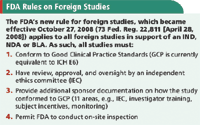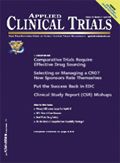RESCUE Medical Writing
Applied Clinical Trials
Two case studies illustrate the potential to turn chaos into meaningful clinical study reports.
In the world of clinical trials, we create detailed development plans, craft thorough study designs, and manage our trials with precision and care. However, the back side of that equation, medical writing of the final study report or clinical study report (CSR), is often a low priority. Once top line results are announced and a summary is generated, the actual CSR can languish for months or even years.

(Digital Vision, Getty Images)

Often the reason these reports are relegated to the lowest priority is that explaining the nuances of the clinical trial and the data generated is arduous and unappealing. Writing a protocol for a new study, however, is fresh and exciting.
For small companies, finding personnel with time available to comb through the tables and listings can be a challenge. For larger companies, gathering the information needed from the various contributors (kineticists, clinical teams, statistical teams, etc.) can be time consuming, particularly when these functions are distributed among separate business units.
And the task of writing some CSRs can be daunting, even for experienced writers. Amendments need to be explained, protocol deviations may require discussion, and data doesn't always present a clear picture. However, the CSR documents the results of the effort and skill of the entire team who contributes to clinical research: clinical management, statistics, data management, pharmacovigilance, regulatory operations, and even the investigators.
So no matter how daunting the task, ultimately the data is why we complete the research and the CSR is how we present that data.
Among the worst circumstances are CSRs that are complicated by personnel or team changes, or CSRs that must be assembled with old data or data contributed by outside partners. For these CSRs, a clear plan for explanation of the study and presentation of the data can seem unattainable.
As illustrated with the case studies that follow, an experienced medical writer will employ certain techniques to make even the messiest situations provide meaningful CSRs. A strategic approach to writing these documents, rescue medical writing, is in order. Let's take a look.
Case One: Changing faces
Company A requires a CSR for a Phase I study completed two years earlier. They hired one CRO to compose the protocol and write the initial draft of the CSR (CRO 1). A second CRO was hired to implement the study, complete the data management and statistics, and provide the SAS output tables and listings (CRO 2).

FDA Rules on Foreign Studies
Both CROs, however, went through multiple staff changes such that different writers and study administrators were involved at different stages. Even at Company A, no single person participated in the implementation of the study for the duration of its lifecycle (from protocol through CSR). To complicate matters, the company went through drastic staff changes during this time, replacing medical directors and clinical personnel so that after its initial draft, the CSR sat unreviewed for over a year.
After a meeting with the FDA, Company A decided that submission of a finalized CSR was needed. They hired the medical writing company Whitsell Innovations, Inc. (WI) to review and finalize the CSR. At the time WI was hired, the study itself had been completed for over two years and the last draft of the CSR was over a year old.
Faulty findings. The writer reviewed the study documents in their entirety, starting with the protocol and working through each data set that would contribute to the CSR (the statistical analysis plan, SAS output tables and listings, the bioanalytical report, and third-party medical reviews).
Upon review of the protocol in conjunction with the bioanalytical report, the WI reviewer noticed that bioanalytical samples for a third of the subjects were not included in the final bioanalytical report. Other potentially spurious data points were noted, such as body weights that did not have matching doses in a mg/kg dosing scenario, subjects who seemed to have been enrolled outside the protocol-specified age ranges, and tables containing too many or too few subjects.
Solutions. In July 1996 the FDA finalized a guidance document1 that outlined an ICH standardized format for the structure of clinical study reports. This guidance offered a clear definition for sponsors of where to locate each aspect of the report's information. While companies are not required to present their data in this format, it is strongly recommended.
Every element of the clinical trial was assigned a specific section under a specific heading, which allowed for the standardization of these documents. This in turn allows the FDA to know where specific information pertaining to each element will be found, as well as defines for the sponsor how to format their report and where to describe the study details.
According to this guidance, the earlier sections of the report detail the IRB information, investigator and sponsor participants (or their designees), and the plan for the execution of the study. The latter sections detail efficacy (and/or pharmacokinetics/pharmacodynamics) and safety.
The keys to resolving the outstanding issues with Company A's CSR were:
- Prioritizing how critical this study was to the Company's development plan
- Understanding how accurate, if at all, the final tables, listings, and bioanalytical data were
- Determining how much of the raw data could be harvested and what samples could be reassessed
- Practically assessing how much Company A could budget toward redoing work.
The WI writer held a meeting with Company A to determine the importance and purpose of the clinical study data. The Company decided that the data and the CSR were critical enough to the study program that thawing old blood samples and rerunning the bioanalytical data to ensure adequacy was required.
As the data seemed questionable but the sponsor believed the CRO running the clinical studies was competent, Company A also agreed to have a new set of tables and listings completed using the same data recollected from the case report forms but with more vigorous data validation and greater oversight.
Despite staff changes and the need to rerun data, the study itself was well planned and the early sections of the report (Sections 1 through 9) effectively documented the intent of the study. So, upon receipt of the new bioanalytical report and the rerun data, the WI writer focused primarily on editing those sections (Synopsis, Abbreviations, Table of Contents, Ethics, Study Administrative Structure, Introduction, Study Objectives, and Investigational Plan).
However, the sections that required the data of the study to be explained (Sections 10 through 12) had to be completely rewritten. Staff changes at the CRO as well as Company A were documented in Section 6.
After the audited data was provided, it became clear that the study was run according to the protocol with only minor deviations. Since the study was open-label, the reevaluation of the bioanalytical samples did not require discussion in Section 9 (under the subheading Changes to the Study or Planned Analysis). The data that appeared spurious in the draft tables and listings was the result of missing sampling times, which were then clearly documented in the pharmacokinetics section of the report and referenced in Section 10 (under the subheading Protocol Deviations).
As the deviations from the protocol design were noted and described, the writer was able to close the loop on how what had been planned for the study differed from what had been implemented. Ultimately, the CSR was able to reflect a better run study and more thorough and accurate data.
Case Two: Multiple amendments
Company B required a CSR for a Phase II study with multiple amendments over the course of the trial. These amendments changed the amount of drug that subjects were dosed, as well as the timing of the dose administration. In addition, inclusion/exclusion criteria were changed and timing of various assessments was altered.
Company B staff members not only didn't know how to write the CSR, they also disagreed on how to organize the data. They hired WI to provide consultation and writing.
Findings. Upon review of the protocol and its amendments, the WI writer noticed that the discussion of study design from the protocol had become convoluted. In turn, the Statistical Analysis Plan had not been updated to incorporate the new subject populations created as the protocol changed.
With each amendment and alteration of the inclusion/exclusion criteria and the dosing regimen, the study created new subject populations, the demographics of the study shifted, and the final numbers of subjects in each group were hard to follow. Consequently, the draft data sets incorporated different numbers of subjects.
The clinical team at Company B disagreed on how the study should be explained and did not see how to create a clear story from the different subject populations.
Solutions. The keys to resolving the outstanding issues with this CSR were:
- Sorting through the amendments to create a coherent story of the rationale for the study and how the study was implemented
- Determining what data was most important to the study and would provide the most critical information to the clinical development of the product
- Building consensus at Company B on these matters.
After much discussion at Company B, the team members decided that total exposure to the investigational agent was the most important factor in this study. They therefore decided that regardless of the inclusion/exclusion criteria changes, subjects who received the same dose for the same duration could be combined into a single subject population.
Where the subject numbers were large enough and changes to the inclusion/exclusion criteria created medically interesting populations, certain subgroups were carved out. This was completed using the date of drug administration and the timing of the amendments.
Other subgroups were created using medical history information, gender, and baseline severity of disease, as these elements did not change over the course of the study. All subjects who received a single dose of study medication were included together in the safety population. All subjects who received placebo were grouped together to be compared to the active arms.
The writing of the early sections of the CSR was fairly sparse and utilized primarily the final version of the protocol. Fortunately, the goals (endpoints and objectives) for the study, as agreed upon by team members at Company B, could be reasonably captured in this document.
In Section 9 (under the subheading Changes to Study or Planned Analysis), the protocol amendments were mapped out methodically by date and number.
The Company and the WI writer agreed that the goal of this CSR was to make the study design—no matter how convoluted it may have been—appear thoughtful and to meaningfully organize the data. After the clinical team reached consensus, the WI writer was able to achieve this.
Mission critical
Though the CSR represents the end of the long process of a specific clinical trial, it is still an important part of clinical development implementation.
An understanding and characterization of a pharmacologic agent can only be provided by having a complete and detailed CSR. And this can only be submitted to the FDA if it appears in the ICH-compliant format. In addition, these documents provide the backbone to the ultimate submission goal of every drug development plan: the NDA.
Sometimes CSRs are straightforward and easy to write. Other times, they require rescue medical writing. With a concrete writing plan, a solutions-oriented mindset, a consensus on the important elements of the study, and a team-based approach between the medical writer and the contributing members of the development team, a workable CSR can be created from the most challenging data.
Robin Whitsell is the president and chief executive officer of Whitsell Innovations, Inc., http://whitsellinnovations.com/, email: robin.whitsell@whitsellinnovations.com
Reference

Improving Relationships and Diversifying the Site Selection Process
April 17th 2025In this episode of the Applied Clinical Trials Podcast, Liz Beatty, co-founder and chief strategy officer, Inato, discusses a number of topics around site engagement including community-based sites, the role of technology in improving site/sponsor relationships, how increased operational costs are impacting the industry, and more.